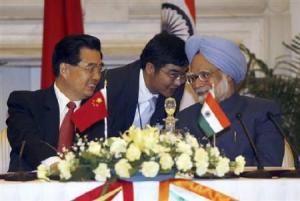 Heads of state from Brazil, Russia, India, China and South Africa otherwise known as the BRICS will be meeting in Sanya, Hainan Province in Southern China for a three-day conference to bolster trade and economic ties. Manmohan Singh, India’s Prime Minister and and Chinese President Hu Jintao, are also expected to meet on the sidelines of the conference to discuss political affairs, trade and security. The BRICS nations account for 40 percent of the global population and 20 percent or one-fifth of the global GDP, up from 18 percent in 2010.
Heads of state from Brazil, Russia, India, China and South Africa otherwise known as the BRICS will be meeting in Sanya, Hainan Province in Southern China for a three-day conference to bolster trade and economic ties. Manmohan Singh, India’s Prime Minister and and Chinese President Hu Jintao, are also expected to meet on the sidelines of the conference to discuss political affairs, trade and security. The BRICS nations account for 40 percent of the global population and 20 percent or one-fifth of the global GDP, up from 18 percent in 2010.
The leaders “will have an in-depth exchange of views on the international landscape, economy, finance, development and other issues, and map out further cooperation among the BRICS countries,” according to a statement from China’s Ministry of Foreign Affairs. The BRICS nations, which is a common grouping for stellar growth economies at a similar economic development stage and a similar foreign trade structure will also focus on global political events, including the crisis in the Middle East and North Africa, Japan’s triple tragedy and energy security. 60 Chinese and foreign experts from think tanks from all five nations met last month to pool resources and ideas together for a consolidated, pragmatic move to be made by their leaders during this meeting.
Regardless of the BRICS growing contribution to the world economy, professionals believe that the differences between the five member countries will out number their commonalities, halting decision making and stalling any conclusive resolution.
One of the major bones of contention between India and China, the widening trade gap at US$19 billion is expected to be discussed, as is China’s widening trade gap with other BRICS nations especially Brazil and South Africa. India which plans to double experts by 2014, by diversifying is also keen to broaden the traded basket of commodities from India to China. India currently exports a majority of raw materials and has increased trade barriers on steel and cotton which are in high demand domestically. As a result of the yawning trade gap, India’s Central Bank, the Reserve Bank of India, is also worried about the low value of the yuan further corroding trade relations between China and India.
However Premier Wen Jiabao’s visit to India last December, did thaw a lot of the ice between the two neighbors. China has since gradually opened up its economy to the Indian pharmaceutical industry, a multi- million dollar investment and is keen on increasing social and financial relations with its southern neightbor. China’s recently released 12th five year plan is also optimistic towards India, highlighting clean energy, technology and service sector collaborations as well as definitive amendments to the FDI policies.
